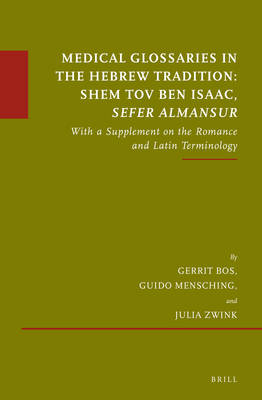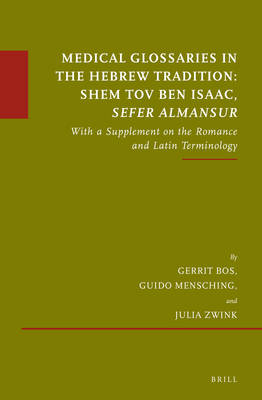
- Afhalen na 1 uur in een winkel met voorraad
- Gratis thuislevering in België vanaf € 30
- Ruim aanbod met 7 miljoen producten
- Afhalen na 1 uur in een winkel met voorraad
- Gratis thuislevering in België vanaf € 30
- Ruim aanbod met 7 miljoen producten
Zoeken
Medical Glossaries in the Hebrew Tradition: Shem Tov Ben Isaac, Sefer Almansur
With a Supplement on the Romance and Latin Terminology
Gerrit Bos, Guido Mensching, Julia Zwink
€ 166,45
+ 332 punten
Omschrijving
The Sefer Almansur contains a pharmacopeia of about 250 medicinal ingredients with their Arabic names (in Hebrew characters), their Romance (Old Occitan) and occasionally Hebrew equivalents. The pharmacopeia, which describes the properties and therapeutical uses of simple drugs featured at the end of Book Three of the Sefer Almansur. This work was translated into Hebrew from the Arabic Kitāb al-Manṣūrī (written by al-Rāzī) by Shem Tov ben Isaac of Tortosa, who worked in Marseille in the 13th century.
Gerrit Bos, Guido Mensching and Julia Zwink supply a critical edition of the Hebrew text, an English translation and an analysis of the Romance and Latin terminology in Hebrew transcription. The authors show the pharmaceutical terminological innovation of Hebrew and of the vernacular, and give us proof of the important role of medieval Jews in preserving and transferring medical knowledge.
Gerrit Bos, Guido Mensching and Julia Zwink supply a critical edition of the Hebrew text, an English translation and an analysis of the Romance and Latin terminology in Hebrew transcription. The authors show the pharmaceutical terminological innovation of Hebrew and of the vernacular, and give us proof of the important role of medieval Jews in preserving and transferring medical knowledge.
Specificaties
Betrokkenen
- Auteur(s):
- Uitgeverij:
Inhoud
- Aantal bladzijden:
- 132
- Taal:
- Engels
- Reeks:
- Reeksnummer:
- nr. 72
Eigenschappen
- Productcode (EAN):
- 9789004352025
- Verschijningsdatum:
- 24/08/2017
- Uitvoering:
- Hardcover
- Formaat:
- Genaaid
- Afmetingen:
- 160 mm x 236 mm
- Gewicht:
- 317 g

Alleen bij Standaard Boekhandel
+ 332 punten op je klantenkaart van Standaard Boekhandel
Beoordelingen
We publiceren alleen reviews die voldoen aan de voorwaarden voor reviews. Bekijk onze voorwaarden voor reviews.








